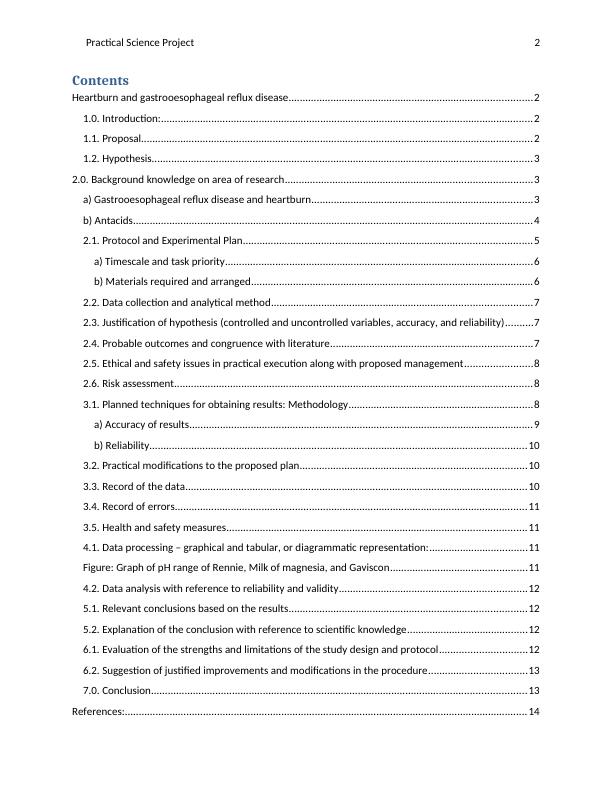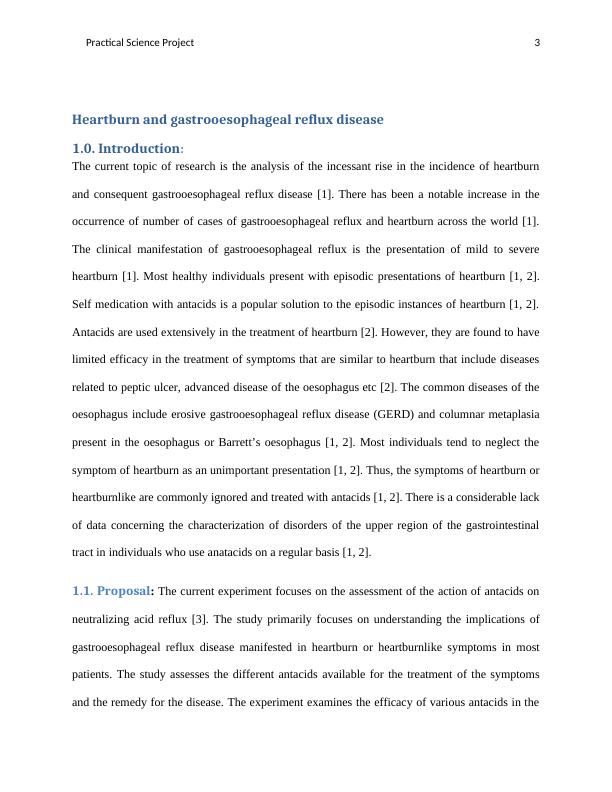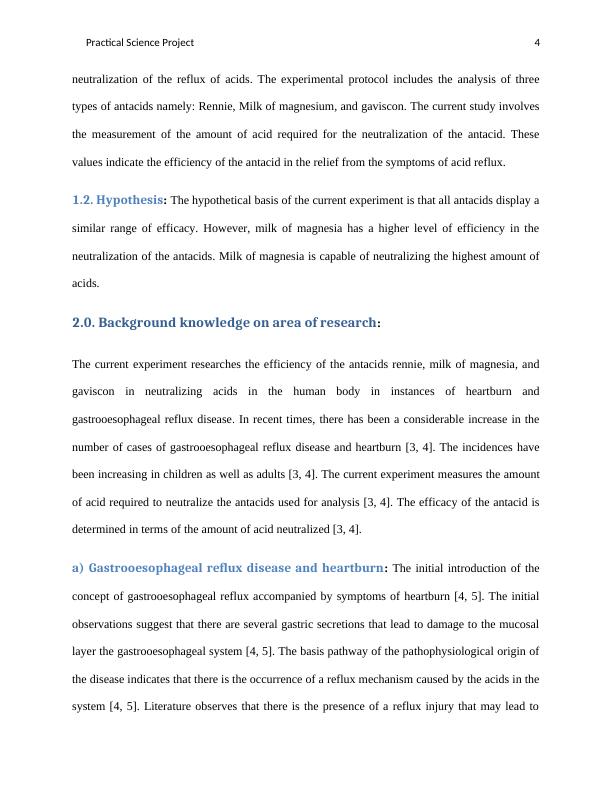Ask a question from expert
Scientific Principles and Research Practices Essay
16 Pages4211 Words220 Views
Added on 2020-07-23
Scientific Principles and Research Practices Essay
Added on 2020-07-23
BookmarkShareRelated Documents
Practical Science Project 1Practical Science Project Student’s Name:Instructor’s Name:Date:

Practical Science Project 2ContentsHeartburn and gastrooesophageal reflux disease.......................................................................................21.0. Introduction:.....................................................................................................................................21.1. Proposal............................................................................................................................................21.2. Hypothesis........................................................................................................................................32.0. Background knowledge on area of research........................................................................................3a) Gastrooesophageal reflux disease and heartburn...............................................................................3b) Antacids...............................................................................................................................................42.1. Protocol and Experimental Plan.......................................................................................................5a) Timescale and task priority..............................................................................................................6b) Materials required and arranged.....................................................................................................62.2. Data collection and analytical method.............................................................................................72.3. Justification of hypothesis (controlled and uncontrolled variables, accuracy, and reliability)..........72.4. Probable outcomes and congruence with literature........................................................................72.5. Ethical and safety issues in practical execution along with proposed management........................82.6. Risk assessment................................................................................................................................83.1. Planned techniques for obtaining results: Methodology..................................................................8a) Accuracy of results...........................................................................................................................9b) Reliability.......................................................................................................................................103.2. Practical modifications to the proposed plan.................................................................................103.3. Record of the data..........................................................................................................................103.4. Record of errors..............................................................................................................................113.5. Health and safety measures...........................................................................................................114.1. Data processing – graphical and tabular, or diagrammatic representation:...................................11Figure: Graph of pH range of Rennie, Milk of magnesia, and Gaviscon.................................................114.2. Data analysis with reference to reliability and validity...................................................................125.1. Relevant conclusions based on the results.....................................................................................125.2. Explanation of the conclusion with reference to scientific knowledge...........................................126.1. Evaluation of the strengths and limitations of the study design and protocol...............................126.2. Suggestion of justified improvements and modifications in the procedure...................................137.0. Conclusion......................................................................................................................................13References:................................................................................................................................................14

Practical Science Project 3Heartburn and gastrooesophageal reflux disease1.0. Introduction:The current topic of research is the analysis of the incessant rise in the incidence of heartburnand consequent gastrooesophageal reflux disease [1]. There has been a notable increase in theoccurrence of number of cases of gastrooesophageal reflux and heartburn across the world [1].The clinical manifestation of gastrooesophageal reflux is the presentation of mild to severeheartburn [1]. Most healthy individuals present with episodic presentations of heartburn [1, 2].Self medication with antacids is a popular solution to the episodic instances of heartburn [1, 2].Antacids are used extensively in the treatment of heartburn [2]. However, they are found to havelimited efficacy in the treatment of symptoms that are similar to heartburn that include diseasesrelated to peptic ulcer, advanced disease of the oesophagus etc [2]. The common diseases of theoesophagus include erosive gastrooesophageal reflux disease (GERD) and columnar metaplasiapresent in the oesophagus or Barrett’s oesophagus [1, 2]. Most individuals tend to neglect thesymptom of heartburn as an unimportant presentation [1, 2]. Thus, the symptoms of heartburn orheartburnlike are commonly ignored and treated with antacids [1, 2]. There is a considerable lackof data concerning the characterization of disorders of the upper region of the gastrointestinaltract in individuals who use anatacids on a regular basis [1, 2]. 1.1. Proposal: The current experiment focuses on the assessment of the action of antacids onneutralizing acid reflux [3]. The study primarily focuses on understanding the implications ofgastrooesophageal reflux disease manifested in heartburn or heartburnlike symptoms in mostpatients. The study assesses the different antacids available for the treatment of the symptomsand the remedy for the disease. The experiment examines the efficacy of various antacids in the

Practical Science Project 4neutralization of the reflux of acids. The experimental protocol includes the analysis of threetypes of antacids namely: Rennie, Milk of magnesium, and gaviscon. The current study involvesthe measurement of the amount of acid required for the neutralization of the antacid. Thesevalues indicate the efficiency of the antacid in the relief from the symptoms of acid reflux. 1.2. Hypothesis: The hypothetical basis of the current experiment is that all antacids display asimilar range of efficacy. However, milk of magnesia has a higher level of efficiency in theneutralization of the antacids. Milk of magnesia is capable of neutralizing the highest amount ofacids. 2.0. Background knowledge on area of research: The current experiment researches the efficiency of the antacids rennie, milk of magnesia, andgaviscon in neutralizing acids in the human body in instances of heartburn andgastrooesophageal reflux disease. In recent times, there has been a considerable increase in thenumber of cases of gastrooesophageal reflux disease and heartburn [3, 4]. The incidences havebeen increasing in children as well as adults [3, 4]. The current experiment measures the amountof acid required to neutralize the antacids used for analysis [3, 4]. The efficacy of the antacid isdetermined in terms of the amount of acid neutralized [3, 4].a) Gastrooesophageal reflux disease and heartburn: The initial introduction of theconcept of gastrooesophageal reflux accompanied by symptoms of heartburn [4, 5]. The initialobservations suggest that there are several gastric secretions that lead to damage to the mucosallayer the gastrooesophageal system [4, 5]. The basis pathway of the pathophysiological origin ofthe disease indicates that there is the occurrence of a reflux mechanism caused by the acids in thesystem [4, 5]. Literature observes that there is the presence of a reflux injury that may lead to

End of preview
Want to access all the pages? Upload your documents or become a member.
Related Documents
Investigating the Impact of HbS Binding to GP1bα on Patients with Sickle Cell Diseaselg...
|16
|3847
|222
Does Physical Activity Reduce Major Depression?lg...
|19
|5325
|108
Depression Mood Disorder | Assignmentlg...
|16
|3551
|313